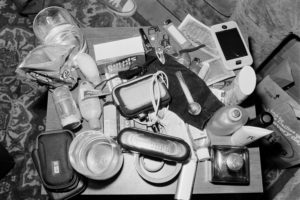
Rian Dundon, Untitled, 2010. From the series Out Here. ©Rian Dundon
In the Bay Area, it has become unremarkable to see people shooting up. National debate continues about whether or not to create “safe injection zones” for intravenous drug users—San Francisco is set to open the first two sites in the nation this summer—but emerging from the BART train at the city’s Civic Center station already feels like walking into one.
These days, the police seem to be taking it a bit easier on junkies, maybe because so many are smacked out to the point of appearing more like harbingers of a general doom than portents of criminal danger. To a young man sitting on the steps at Civic Center poised to plunge a needle into his exposed groin, they now shake their heads and say things like “Move along.” No confrontation, no zip-tie handcuffs. An air of de facto decriminalization has wafted in, and drug users and law enforcement appear to be living in disconcerting harmony. It’s hard to tell whether it’s born of greater goodwill, deeper resignation, or both.
Recently, the president elaborated upon his cops-and-robbers view of the drug trade when he suggested that drug dealers be given the death penalty. As the public health officials who roundly criticized the comment were quick to note, the president’s desire to condemn dealers to the costly bureaucratic purgatory that is death row demonstrates an appalling lack of understanding—of the drug economy, the legal system, and addiction. But perhaps it’s not a surprising viewpoint for a guy obsessed with “getting tough” on everyone and everything, or one who thinks Duterte is doing a “great job” fighting his country’s drug problem.
In another reprisal of the Reagan 80s, the president said to the same crowd in New Hampshire—which had the third-highest death rate in the country from overdoses in 2017—“we’re thinking about doing, really, a large-scale rollout of commercials that show how bad it is for the kids. And when they see those commercials, hopefully, they’re not going to be doing drugs—drugs of any kind.”
One piece of the administration’s public campaign to combat the opioid epidemic is a new government website, CrisisNextDoor.gov, where people can post short videos of themselves talking about how they “overcame addiction, volunteered at a recovery center, or worked as a family to help a loved one get on the path to recovery.” It’s an attempt to humanize the opioid crisis by foregrounding real stories, and to offer hope that there is a way out. Unsurprisingly, it is also carefully curated. I was only on the second page when I found the video of a middle-aged blond woman whose son, a crack and heroin addict, had finally reached out to ask his family for help: “I just want to thank you, President Trump, for everything that you are, everything that you’re doing, and all that you have been doing for our country…You touch the heart, the root of all of our problems here in the U.S., and you help us. So I thank you personally.”
People are dying, we keep hearing. The problem has spiraled out of control. And in the age of social media deployed for social justice, we are primed to believe that one sure way to combat it is increased visibility. In liberal shorthand, visibility equals empathy. If we show it more, people will care more, the stigma will be dismantled, and addicts will fare better. There is truth to this, but all representation is not created equal, and even as we are told that the demographics of opioid use have dramatically changed the addiction picture in America, pictures of addicts themselves have changed very little. The majority of images of the opioid crisis reproduce a dangerously flattened idea about who does drugs, where, how, and—most importantly—why they do them. Which means that, while more visible, the problem may not be more legible, more urgent, or more real-seeming. Without context, visibility in this case often feels more like voyeurism.
*
In February, my boyfriend and I cuddled weekly on the couch to watch The Trade, a gritty, five-part Showtime documentary series about the opioid epidemic. The show has no narration, and follows the boss of a poppy production operation in Guerrero, Mexico, police in Dayton, Ohio, and middle-American families devastated by addiction, ostensibly in pursuit of putting a human face on the problem. It is both riveting and terrible. One grainy video clip, which showed a toddler trying to rouse their overdosed mother in a supermarket aisle, stayed with me for days. But apart from a few such glimpses of sheer horror, The Trade mostly had the superficiality of an action movie. There were the Mexican poppy growers shipping product like it’s any other widget, good cops grateful to go home to their intact families after fighting bad guys all day, and an undifferentiated string of pallid addicts with no visible interiority to speak of. My boyfriend, a recovering heroin addict, bored quickly of the familiar plotlines. He interjected occasionally to write off certain addicts, colorless young people on the nod amid shabby lawn furniture in their parents’ backyards. One kid kept promising and promising his mom he wouldn’t get high, and then there he’d be, a cigarette hanging nearly vertically from his lips as he almost tipped out of a plastic chair. “This poor asshole is never gonna make it,” my boyfriend said, and went into the kitchen for a snack.
By the third episode, we had to laugh at the show’s unrelenting grimness. The message was plain: In opioid country, life is drugs, cops work hard, and joy is simply not on the menu. On The Trade, even recovery, something my boyfriend and I approach daily with as much gusto and gratitude as we can muster, looks awful and impossible, a steep climb toward—what, a haircut? If the addicts it showed had lives before drugs—hopes, dreams, plans, personalities—there was little evidence of them. In this telling of the story, and in so many others, it seems addicts are there to index the “lives cut short” by drugs. They are the kids who should have just said no.
A reviewer of The Trade in Paste argues, “Junkies don’t make good television because they are really, really damned boring….heroin turns most people into zombie reptiles who are deeply depressed and deeply depressing. Drug dealers? Ditto. They are boring!” The piece goes on to criticize the show for its oversimplification and for failing to implicate the federal government for its role in the drug crisis, and then argues for more nuanced depictions. People must “get past the ‘drugs bad; stop the Mexicans’ mode of looking” at the situation, the reviewer writes. The epidemic, after all, is “claiming real people’s lives, it is bereaving real families, orphaning real children.”
Addiction can make people rather single-minded, but it’s sad to me that even in calls for complexity and compassion, addicts are portrayed as “zombie reptiles.” That’s just how deeply rooted the stigma of addiction is, and how powerfully life-destroying today’s drugs are. This piece—ironically, like the show it critiques—underscores just how hard it is to take addicts seriously as whole people. This disease is claiming real zombie reptile lives, bereaving the real families of zombie reptiles, we are told. Is it any wonder that we struggle to give a shit? The proliferation of a kind of heroin porn may be normalizing the epidemic, but it is failing to humanize it. How many times can we look at the same stock images of a needle in an arm and be expected to feel something?
In her essential 1999 book about AIDS, How To Have Theory in an Epidemic, Paula Treichler writes of television coverage, “Patterns of AIDS coverage on the networks seem at times so identical that one imagines their representatives all at the same AIDS workshop—learning how to give events the same conventional interpretations, select the same AIDS experts, use the same misleading terminology, and recite the same pieties about scientific progress.” We’re living through a very different epidemic, on which there has been some very good reporting, but there remains a striking sameness to much of the mainstream coverage that recalls Treichler’s description. “Maybe you just want to see more charismatic addicts,” a friend says when I complain about this. “Yes!” I shout. “We need our Cleve Jones! We need our fucking quilt.”
The entrepreneurs of the recovery industry peddle fraught hope, but anyone in recovery can tell you that real hope comes from other recovering people, other actual humans who have set their lives back on course. This is the principle underlying Twelve Step programs—that sharing our “experience, strength, and hope” will help others recover. And listening to others’ stories is, at its core, a genuine act of empathy. In a recent interview with NPR, Leslie Jamison discusses the impetus for including others’ addiction stories in her new memoir The Recovering: Intoxication and Its Aftermath. When you’re going to AA meetings, she says, “you are constantly kind of paying attention to lives outside of your own. And that gave me a kind of hunger and a kind of practice with engaging with other people’s stories.” Perhaps the empathy gap persists because too few people get to hear these stories in real life—not just of the spiral downward, but of the ever-changing, strenuous, humbling and rewarding hike back up.
I recently revisited a 1986 essay by Ellen Willis titled “The Drug War: From Vision to Vice.” The piece, which begins with a reflection on tripping while young and single, goes on to say that all drugs are different, and that people do them with different intentions, but “the ideological assault on drugs has conflated them all.” The “authoritarian” impulse to curtail and control drug use has produced a view of all drugs simply as “vice,” Willis writes, and “the gap between ideology and behavior is increasingly filled with hysteria.” This was the height of the War on Drugs, when drug use was criminalized and users were punished harshly. The hysteria centered around crack cocaine. While writing, Willis peruses a Newsweek cover story titled “Kids and Cocaine: An Epidemic Strikes Middle America” that could be written today if you substituted heroin for cocaine.
We are now moving, albeit glacially, toward a more humane approach to drug use and addiction recovery. (Faster for certain drugs, of course: “Hello marijuana, goodbye stress,” reads a bright California billboard for weed-delivery company Eaze.) But a similar mood prevails. There remains a familiar hysteria among some moralizing forces that see drugs as anathema to decency. There is the related panic of the capitalist state, which drug-tests its employees (not out of fear of lost humanity, but of lost productivity). Mainstream magazines run cover stories about this unprecedented scourge and show so many images of people shooting up that it becomes hard to tell them apart or to care. What I understand Willis to be saying is that a view of drugs with its origins in government is bound to be essentially wrong, a misunderstanding. When I read her piece, I realize that so much of the coverage of this epidemic feels off for exactly this reason: we’re still getting the story from the top.
*
In February, Andrew Sullivan wrote a sweeping New York magazine piece, “The Poison We Pick,” in which he traces the romantic history of opium, which has an “oddly calming and euphoric effect on the human brain,” back to Neolithic Europe (6000 years ago), and claims that the current epidemic is a symptom of civilizational crisis, a problem of modernity that he links to deindustrialization.
Sullivan naturalizes the impulse to use opiates by writing in the register of grand despair, and by linking the drug to a long line of Great Men. He reminds us that mothers once gave their babies opiate syrups to soothe them. He tries to do addicts a solid by telling readers that they do drugs because it feels good, even citing the ur-junkie memoir, Thomas De Quincey’s Confessions of an English Opium-Eater, published in 1821. As if we need proof from two centuries ago to imagine the numbing bliss of OxyContin. Then, in a historical analogy that struck me as wildly off-key, Sullivan likens the “dying gay men who joined ACT UP in the 1980s” to the “opioid-ridden communities who voted for Donald Trump in unexpected numbers” because both are “living through a plague that others are choosing not to see.”
Toward the end of the long piece, Sullivan writes that elites in America remain able to “ignore the scale of the crisis because it is so often invisible in their—our—own lives.” That “our” really got me. It reminded me that most of the voices we hear talking about the opioid epidemic are not those of people who have been directly impacted. To them, the “poppy’s power” is an abstraction. When we do see real faces of the crisis, as in The Trade, they are muzzled by active addiction—high and hopeless, symbols rather than people.
I’m tired of listening to politicians and police officers and Andrew Sullivans talking about junkies. I want to hear junkies talking. Not with their faces blurred out, not caught on film while copping or shooting up or carrying their life’s possessions through a parking lot. Not in the service of confirming something we think we already know about sickness or failure. I want to hear the first-person stories of drug users and drug addicts—and of their families and loved ones—in all of their diversity and anguish and fortitude. If there is any hope to be found, it is in this daily muddling through.
Nina Renata Aron is a writer and editor based in Oakland, California. She is a features editor at Full Stop. Find her online at @black_metallic.
This post may contain affiliate links.







